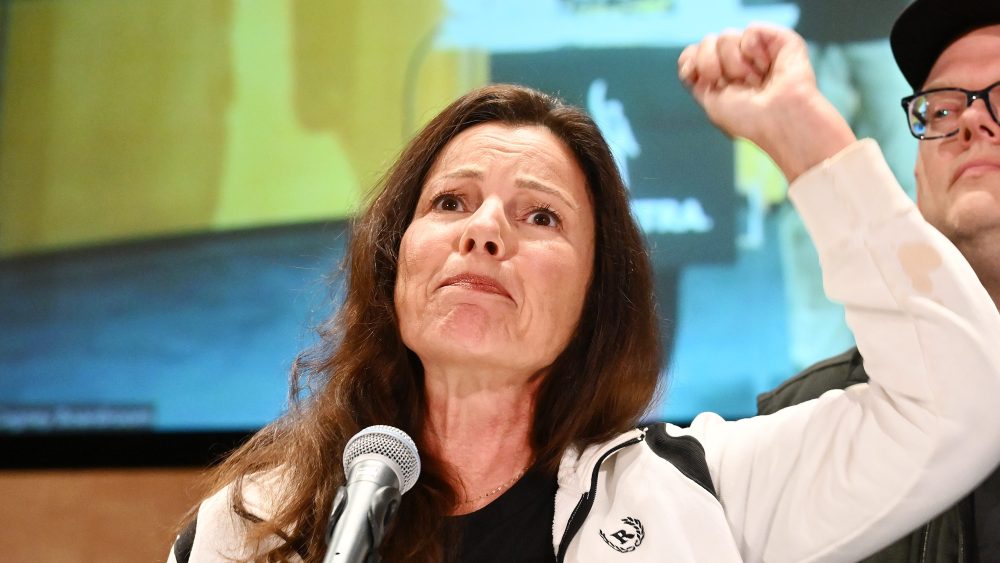
SAG-AFTRA and the major studios remain at odds on a dizzying array of issues, as film and TV actors hit the picket lines Friday for the first time since 1980.
According to sources on both sides, the biggest sticking point is the union’s demand for 2% of the revenue generated by streaming shows. The two sides also remain far apart on basic increases in minimum rates, with the studios offering 5%, 4% and 3.5% across the three years of the contract, while the union is demanding 11%, 4% and 4%.
But that only scratches the surface. The parties are at odds on dozens of issues, only a handful of which have been publicly reported.
In some cases, the two sides don’t even agree on what the disagreements are. They engaged in a rare public back-and-forth Thursday over the use of artificial intelligence to replicate background actors.
Duncan Crabtree-Ireland, the union’s executive director, alleged that the studios want to pay an extra for one day of work to be scanned, and then reuse that likeness forever. The Alliance of Motion Picture and Television Producers hotly disputed that, saying that its proposal explicitly limits the reuse to the project for which the extra was hired.
Here is a breakdown of the disagreements — both major and minor — that led to the strike.
SAG-AFTRA wants 2% of the revenue that each show generates for a streaming platform to be paid to performers. The union would use Content Valuation, a measurement tool introduced last fall by Parrot Analytics, to determine how much each show is worth to the platform.
Parrot Analytics uses Google searches, social media mentions, and other data sources to measure demand for each show. The metric is not trying to determine viewership, but rather the impact of each show on a company’s revenue. To estimate that, it uses quarterly earnings data and apportions revenue — including subscriptions and ads — to each show on the platform.
SAG-AFTRA — led by union president Fran Drescher — argues that it is essential to pay performers for the success of a show. The union says it is not wedded to Parrot Analytics, but that the studios have not countered with any other way to measure performance. The studios say they explained early and often that the whole concept is unworkable given the challenges of accurately measuring success.
Drescher was the “inspiration” behind the proposal, according to Crabtree-Ireland. Discussing the subject in the room, she told AMPTP negotiators that her father, Morty, is a systems analyst, and that she “sees systems.” She also made it clear that this contract issue is her top priority.
The AMPTP has offered the same economic terms to SAG-AFTRA that were approved by the Directors Guild of America. That includes a 5% increase to most minimum rates in the first year of the contract, followed by increases of 4% and 3.5%. SAG-AFTRA argues that does not keep pace with inflation, and has demanded 11%, 4% and 4%.
The AMPTP also offered additional increases for certain categories of performers: 11% for background actors and 58% for guest stars on streaming shows. (On the latter item, SAG-AFTRA accepted the increase.)
SAG-AFTRA is also seeking a 230% increase in foreign streaming residuals, according to a studio source. The AMPTP is offering the same increase provided to the DGA: 76%.
SAG-AFTRA is not seeking to ban AI, but wants to make sure that any use of a performer’s likeness to generate a new performance is done with compensation and consent. The AMPTP says it has agreed to that, but Crabtree-Ireland said the devil is in the details.
“It is a very craftily put together proposal that a layperson looking at it might not see all the holes in it,” he said. “There are huge gaps you can drive a Mack truck through.”
RELATED CONTENT: SAG-AFTRA Issues Strike Rules: No Premieres, Awards Shows, FYC Events
The union wants to require that a performer has to consent to any use of their performance to train an AI system. The AMPTP would accept that for AI training used to alter or recreate that performer’s likeness. But according to Crabtree-Ireland, the AMPTP would give studios carte blanche to train AI systems to create “synthetic” performers, or for other purposes.
SAG-AFTRA also wants studios to get union consent on individual uses of AI, which the studios have refused to grant. There is also the dispute over background actors.
SAG-AFTRA wants to limit the use of self-taped auditions, which have become the industry standard in the wake of the pandemic. The union wants to limit such auditions to no more than five pages of material. The AMPTP has offered an eight-page limit. The two sides are also working on terms about turnaround times and a provision that would clarify no special lighting or equipment is needed.
- Pension and health contributions
Producers pay contributions to the pension and health plans based on performers’ earnings up to a certain threshold. For a half-hour episode, the ceiling is $15,000; for an hour it’s $24,500. SAG-AFTRA wants to increase those ceilings to $45,000 and $75,000, respectively, to account for 40 years of inflation. The AMPTP has agreed to increase the ceilings to $20,000 and $30,000.
Actors Access is a website that holds a virtual monopoly on the posting of casting notices. Actors can sign up and post their bios and audition materials and get connected to jobs. The site has both a free tier and a premium tier, and there is a fee to upload reels. SAG-AFTRA argues that those who pay for the premium tier get preferential treatment. The union would mandate that actors seeking work under the contract would not have to pay for access to jobs.
RELATED CONTENT: Fran Drescher Slams Bob Iger’s ‘Repugnant’ and ‘Tone Deaf’ Comments
Gary Marsh, who runs the company, said that actors do not have to pay to upload audition materials. He said he was not familiar with how his company was implicated in the negotiation. The AMPTP has argued that it can’t agree to a provision targeted at a third party who is not part of the negotiation.
- Option periods for TV actors
In the streaming era, actors have been forced to wait for longer and longer periods to hear whether their show has been renewed. This is one of the primary ways in which the shift to streaming has affected actors’ pay. SAG-AFTRA struck a deal with Netflix last year that limits option periods to 18 months from the start of production on a season. The union would like to get the same deal with the rest of the companies represented by the AMPTP. The studio group says it has agreed to do so for actors earning less than $65,000 an episode on half-hour shows and less than $70,000 an episode on one-hour shows.
- Background actors outside Los Angeles and New York
The SAG-AFTRA contract covers background actors only in a handful of places around the country — most importantly, New York and Los Angeles. The union would like to represent extras throughout the U.S. The AMPTP argued that it cannot use the contract negotiation to expand its jurisdiction, and that is a non-mandatory subject of bargaining. SAG-AFTRA withdrew the proposal.
SAG-AFTRA also argues that its contract should cover performance-capture acting. Performance-capture is not explicitly covered, though much of that work is done under contract terms anyway. As with the background actor issue, the AMPTP has said that the union is improperly using the negotiation to expand its jurisdiction.
(Pictured: SAG-AFTRA president Fran Drescher)











